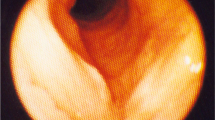Abstract
This study aimed at studying the histopathological effects of hyperandrogenemia and estrogen deficiency on larynx mucosa in experimentally designed polycystic ovary syndrome of female rats. Two groups of experimental polycystic ovary syndrome model were composed in healthy female rats by per oral letrozole administration of for 21 and 42 days. Also a control group which only took vehicle (saline) for 42 days was designed. Laryngeal mucosa and ovaries of all animals were examined histopathologically by light microscopy and the serum hormone levels were analyzed using a solid-phase, two-site chemiluminescent enzyme immunometric assay. Statistically significant edema, vascular engorgement, inflammation, cilia loss and differentiation of goblet cell distribution were observed when the control group and study groups were compared (p < 0.01). In serum hormonal analysis there was a significant increase in levels of androgens and decrease in levels of estrogens. In addition, polycystic appearance of ovaries in letrozole-administered groups and normal appearance of ovaries in control group have been proven histopathologically. Polycystic ovary syndrome which causes estrogen deficiency and hyperandrogenemia in fertile ages resulted in histopathological changes in laryngeal mucosa.




Similar content being viewed by others
References
Serra a, Maiolino L, Agnello C, Messina A, Caruso S (2003) Auditory brainstem response throughout the menstrual cycle. Ann Otol Rhinol Laryngol 112:549–553
Caruso S, Cianci A, Grasso D et al (2000) Auditory brainstem response in postmenopausal women treated with hormone replacement therapy: a pilot study. Menopause 7:178–183
Caruso S, Maiolino L, Agnello C, Garozzo A, Di Mari L, Serra A (2003) Effects of patch or gel estrogen therapies on auditory brainstem response in surgically postmenopausal women: a prospective, randomized study. Fertil Steril 79:556–561
Doty RL (1997) Studies of human olfaction from the University of Pennsylvania Smell and Taste Center. Chem Senses 22:565–586
Grillo C, La Mantia I, Triolo C, Scollo A, Intelisano G, Caruso S (2001) Rhinomanometric and olfactometric variations throughout the menstrual cycle. Ann Otol Rhinol Laryngol 110:785–789
Caruso S, Grillo C, Agnello C, Maiolino L, Intelisano G, Serra A (2001) A prospective study evidencing rhinomanometric and olfactometric outcomes in women taking oral contraceptives. Hum Reprod 16:2288–2294
Caruso S, Grillo C, Agnello C, Di Mari L, Farina M, Serra A (2004) Olfactometric and rhinomanometric outcomes in postmenopausal women treated with hormone therapy: a prospective study. Hum Reprod 19(2859):64
Caruso S, Roccasalva L, Sapienza G, Zappala` M, Nuciforo G, Biondi S (2000) Laryngeal cytological aspects in women with surgically induced menopause who were treated with transdermal estrogen replacement therapy. Fertil Steril 74:1073–1079
Caruso S, Roccasalva L, Di Fazio E et al (2003) Cytologic aspects of the nasal respiratory epithelium in postmenopausal women treated with hormone therapy. Fertil Steril 79:543–549
Caruso S, Serra A, Maiolino L et al (2006) Cytological aspects of the nasal respiratory epithelium in reproductive-age women taking oral contraceptives. Eur J Contracept Reprod Health Care 11(4):250–257
Rios OA, Duprat Ade C, Santos AR (2008) Immunohistochemical searching for estrogen and progesterone receptors in women vocal fold epithelia. Braz J Otorhinolaryngol 74(4):487–489
Schneider B, Cohen E, Stani J et al (2007) Towards the expression of sex hormone receptors in thehuman vocal fold. J Voice 21(4):502–507
Surmeli M, Habesoglu TE, Habesoglu M et al (2011) Histopathological effects of estrogen deficiency on larynx mucosa in ovariectomized rats. Eur Arch Otorhinolaryngol 268(2):261–266
Azziz R, Woods KS, Reyna R, Key TJ, Knochenhauer ES, Yildiz BO (2004) The Prevalence and Features of the Polycystic Ovary Syndrome in an Unselected Population. J Clin Endocrinol Metab 89(6):2745–2749
Asunción M, Calvo RM, San Millán JL, Sancho J, Avillo S, Escobar-Morreale HF (2000) A prospective study of the prevalence of the polycystic ovary syndrome in unselected caucasian women from Spain. J Clin Endocrinol Metab 85:2434–2438
Singh KB (2005) Persistent estrus rat models of polycystic ovary disease: an update. Fertil Steril 84(Suppl 2):1228–1234
Kilic-Okman T, Kucuk M, Altaner S (2003) Comparison of the effects of letrozole and clomiphene citrate on ovarian follicles, endometrium, and hormone levels in the rat. Fertil Steril 80(6):1330–1332
Kafali H, Iriadam M, Ozardali I, Demir N (2004) Letrozole-induced polycystic ovaries in the rat: a new model for cystic ovarian disease. Arch Med Res 35(2):103–108
Baravalle C, Salvetti NR, Mira GA, Pezzone N, Ortega HH (2006) Microscopic characterization of follicular structures in letrozole-induced polycystic ovarian syndrome in the rat. Arch Med Res 37(7):830–839
Wu KH, Tobias MI, Kelley DB (2001) Estrogen and laryngeal synaptic strength in Xenopus laevis: opposite effects of acute and chronic exposure. Neuroendocrinol 74(1):22–32
D’haeseleer E, Depypere H, Claeys S, Wuyts FL, Baudonck N, Van Lierde KM (2011) Vocal characteristics of middle-aged premenopausal women. J Voice 25(3):360–366
Newman SR, Butler J, Hammond EH, Gray SD (2000) Preliminary report on hormone receptors in the human vocal fold. J Voice 14(1):72–81
Kahane JC (1982) Growth of the human prepubertal and pubertal larynx. J Speech Hear Res 25(3):446–455
Fitch WT, Giedd J (1999) Morphology and development of the human vocal tract: a study using magnetic resonance imaging. J Acoust Soc Am 106(3 Pt1):1511–1522
Higgins MB, Saxman JH (1989) Variations in vocal frequency perturbation acro, the menstrual cycle. J Voice 3:233–243
Mun Ester, Christensson Birger, Gronneberg Reidar, Larsson Kjell (2005) Noneosinophilic CD4 lymphocytic airway inflammation in menopausal women with chronic dry cough. Chest 127:1714–1721
Talaat M, Talaat AM, Kelada I, Angelo A, Elwany S, Thabert H (1987) Histological and histocheınical study of effects of anabolic steroids on the female larynx. Ann Otol Rhinol Laryngol 96:468–471
Conflict of interest
We do not have any financial relationship with the organization that sponsored the research nor conflict of interest.
Author information
Authors and Affiliations
Corresponding author
Additional information
The study was done in Haydarpaşa Numune Education and Research Hospital.
Rights and permissions
About this article
Cite this article
Deveci, H.S., Deveci, I., Habesoglu, M. et al. Histological evaluation of rat larynx in experimental polycystic ovary syndrome model. Eur Arch Otorhinolaryngol 269, 1945–1950 (2012). https://doi.org/10.1007/s00405-012-1978-7
Received:
Accepted:
Published:
Issue Date:
DOI: https://doi.org/10.1007/s00405-012-1978-7




